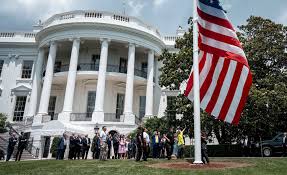After the longest shutdown in American history hampered air travel, reduced food assistance for low-income Americans, and left over a million workers underpaid for more than a month, the U.S. government is scheduled to resume operations on Thursday.
However, the profound political differences that first led to the 43-day closure are still unresolved.
There aren’t many safeguards in the funding package to prevent Republican President Donald Trump from cutting spending in an administration that has frequently contested Congress’s constitutional power over funds.
Furthermore, it doesn’t deal with the insurance subsidies that are about to expire, which is what first prompted Senate Democrats to start the shutdown.
The shutdown also revealed divisions within the Democratic Party between its moderates, who believe their options are constrained as long as Republicans maintain majorities in both chambers of Congress, and its leftist base, which has demanded that its leaders take all necessary steps to restrain Trump.
Despite his vote against the agreement, Senate Democratic Leader Chuck Schumer is being urged to resign.
Republicans and Democrats are blamed by Americans about equally.
It doesn’t seem like either side has emerged victorious.
According to a survey published on Wednesday, 47% of Americans blamed Democrats for the shutdown, while 50% blamed Republicans.
Since the agreement only provides funding to the government until January 30, the return to normalcy may not last long, increasing the likelihood of another shutdown early next year.
Republicans have more often been the party that pushed budget expirations over the past few decades, so the shutdown placed Democrats in an uncommon position.
The argument over the $38 trillion national debt, which Congress currently places on a path to continue expanding by around $1.8 trillion annually, was another notable aspect of this shutdown.
To draw attention to the impending spike in health insurance costs for around 24 million Americans, Senate Democrats said that the economic suffering, including disruptions in federal benefits and lost wages for federal employees, was worthwhile.
Representative Hank Johnson of Georgia stated, “I’m proud that Democrats held together for this long to fight this battle. The healthcare of the American people is a fight worth having.”
“The American people are increasingly conscious of the importance of the battle we are engaged in… They urge us to fight because they recognize how dangerous the situation is.
Democrats were only able to gain a promise that the Republican-controlled Senate would vote on health subsidies; they were not given any guarantees that the House would even vote on the issue or that it would pass.
However, they said that they were able to raise awareness of the issue at a time when surveys indicate that Americans are worried about the growing expense of living, and that Republicans risk electoral backlash if they do nothing to stop insurance premiums from rising.
Residents of states governed by Republicans gain disproportionately from the subsidies.
Republicans, on the other hand, were forced to make claims that Democrats frequently made during shutdowns: that the harm caused by the disruptions was not worth it.
Republican moderate Representative Brian Fitzpatrick told reporters, “We ought to be legally prohibited from ever shutting down the government.”
The fact that we are now utilizing government shutdowns as leverage for policy is just completely absurd. It’s definitely a bad precedent to set, and that can never occur.”
FOOD BENEFITS AND FLIGHTS TO RESUME
Following thousands of flight cancellations caused by high absence rates among the country’s air traffic controllers, the country’s air travel system has started to return to normal.
Additionally, 42 million Americans won’t have to worry about their SNAP benefits, which help them pay for groceries, running out.
Most states will get funding for full SNAP payments within 24 hours of the government reopening, according to a USDA representative.
Hundreds of thousands of federal workers were obliged to continue working unpaid due to the shutdown, while others who were deemed unnecessary were told not to work.
A 2019 law requires them to receive their back pay, but Trump’s White House has threatened to deny some of them compensation.
During the shutdown, Trump also attempted to fire thousands of federal employees, carrying out his pledge to target Democratic-friendly domestic programs.
In addition to allowing those employees to maintain their jobs, the agreement that ends the shutdown delays Trump’s larger downsizing initiative until the end of January.
By the end of the year, Trump plans to cut 300,000 employees from the 2.2 million-person civil service.
Due to the government’s inability to release a variety of economic statistics due to the shutdown, investors and the Federal Reserve were unable to evaluate the situation of the largest economy in the world.
Ahead of the year-end holiday shopping season, it also alarmed customers.
According to the nonpartisan Congressional Budget Office, it would reduce U.S. GDP by 1.5 percentage points and delay spending by about $50 billion. Although up to $14 billion in lost economic activity will not be recovered, the CBO predicted that the economy will mostly recover after the shutdown.
















